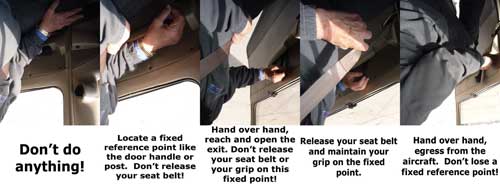
“No, your eyes aren’t playing tricks on you. While the chances of staying upright in a ditching are fairly good, even if you don’t, right is right and left is left when your seatbelt is secured. If possible, use a hand-over-hand technique to locate and open the exit before releasing your seatbelt. Then, maintain your grip on a known fixed point like the door handle, and follow that path out of the aircraft. Practice this maneuver while seated in your aircraft on the ground, and consider egress training and water survival courses if the opportunity presents itself.”
by Rachel Obermoller
Aviation Representative MnDOT Office of Aeronautics
Every pilot has pondered whether it’s better to go over or around a body of water. Whether it’s a relatively small lake while entering the traffic pattern, Lake Mille Lacs in Central Minnesota or Lake Michigan while venturing from Wisconsin to Michigan, the way pilots have been trained to think inevitably leads them to consider what would happen should the engine fail, or another emergency occur, at such an inopportune time. Some pilots set rules for themselves, such as “Never in a piston airplane” or “Only in a twin/seaplane/turbine,” but the fact of the matter remains that throughout the Midwest, pilots are forced to fly across water to reach their destinations, whether in cruise or the traffic pattern.
One only needs to take off from St. Paul Downtown Airport or approach to land over the water at La Crosse to see that quite a few airports have “water hazards” nearby. We aren’t trying to discourage pilots from using airports proximate to water or to create unnecessary fear, but it is important to consider that even the rules we set as our own personal minimums don’t eliminate all the risk.
A good pilot is prepared for a multitude of potential abnormal or emergency situations including water egress from an airplane.
The risk of ditching is relatively small, and the chances of survival are quite high – research suggests upwards of 95% of ditching results in successful egress. A pilot can certainly hedge the odds favorably with a little planning, training, and the right gear. So, let’s discuss what needs to be done in the event of a real emergency, such as an engine failure on takeoff when oriented towards a body of water, a loss of power insufficient to maintain altitude when on approach over a river or lake, or as we saw with the “Miracle on the Hudson,” a ditching in an urban environment where the worst option in most other situations was also the best option.
Setting Up To Ditch
Obviously, the best scenario for any emergency is one where the pilot has adequate time to prepare, has previously rehearsed the emergency in a low-risk environment, such as a simulator or during training with a competent instructor, and has the necessary knowledge and equipment to deal with the emergency.
Pilots practice simulated engine failures when they prepare for a checkride, but when was the last time you reviewed the procedures in the airplane, either static on the ground to rehearse the procedures, or as part of a flight review or other training event with an instructor in flight?
There are a number of things which could necessitate an emergency landing including engine or propeller malfunctions, fire, or flight control malfunctions. An emergency during cruise or with a little advance warning affords the pilot some time to prepare. An emergency on takeoff or approach at 200 feet over water does not. This is where at least a little rehearsal ahead of time is important. Know what your aircraft manufacturer recommends for ditching the aircraft, have a basic idea in your head of what you will do when faced with this type of emergency, and know the procedures for your aircraft that you can accomplish to try to maintain or restore power while maintaining control of the aircraft.
Start thinking about some of this way in advance, before you ever leave the ground. Also consider the equipment you carry onboard the aircraft including appropriate clothing for the conditions, survival gear, flotation devices, rescue aids such as portable ELTs, and tracking and signaling devices. Where is this equipment located and would it be accessible in the event of a water landing?
The rule of thumb is once you are out the door of the aircraft, you don’t go back in. Some seaplane pilots are known to carry survival gear in a dry bag in their float locker for this reason, and pilots whose work requires low-level flying commonly wear vests which incorporate pockets for basic survival gear.
If you frequently fly over water, you might consider investing in continuous-wear inflatable personal floatation devices (PFDs). These come in various forms including waist-pack, lightweight collar, or even integrated vest PFDs, but should never be the type which automatically inflate on contact with water or contain foam. The wearer should control when the device inflates so he can egress from the aircraft before the PFD becomes buoyant. A PFD also works best when worn instead of needing to be donned in an emergency.
Consider as well how your exits will operate, whether submerged or on the surface of the water, and upright or upside-down.
For example, the aft two-part doors on a Cessna 206 are blocked by the flaps when they are extended. Because the flaps require an electric motor to extend or retract, this may render the aft door unusable at worst, or require significant strength to force the back half of the door open at best if the flaps are extended.
If there is significant pressure differential between the cabin and exterior, it may be necessary to relieve this pressure before an exit can be opened. This can include opening a door or window, or in an extreme situation, forcing out a door or window by bracing and using leg strength to create an exit path through plexiglass in an unpressurized aircraft.
Passengers are also an important part of the equation, and a thorough briefing is an important part of any flight.
As pilots, we should weigh the passengers’ need to know against their level of fear and familiarity with the aircraft. At a very minimum, with respect to egress and the potential for an off-airport land or water landing, passengers should understand how to operate their seatbelt and shoulder harness, open any exits and secondary exits, where the emergency equipment and survival gear are located, and know what you will expect from them as part of a routine flight, as well as should an emergency occur or a need to egress exist.
Contacting The Water
As a pilot prepares to ditch in an aircraft in the Midwest, and really, much of the United States, he can generally assume that pointing the aircraft into the wind is the best course of action. In large bodies of water on windy days, the swells may be quite large or close together, and the pilot may elect to touch down perpendicular to a swell to minimize the potential for immediate capsize if he determines that this is the best course of action. Otherwise, pointing the nose into the wind will generally put the aircraft perpendicular to the waves at minimum groundspeed upon contact with the water, which is ideal, and allows the pilot to use his familiar soft-field landing technique. There are numerous ways to determine the direction of the surface wind, including knowledge about the winds in the area, reading flags and windsocks nearby, looking for the calm upwind shore on a body of water, or watching the swell pattern on the surface of the water.
Some aircraft manufacturers and pilots may recommend opening an exit prior to touchdown to facilitate egress and prevent the exit from jamming closed, while others recommend keeping exits closed to preserve structural integrity until egress is required. Check your aircraft’s POH, and in the absence of information on this subject, weigh the pros and cons for yourself.
Data indicates the risk of immediate capsize in both low-wing and high-wing, as well as fixed-gear and retractable-gear aircraft, is relatively low, however the potential exists for any aircraft to end up upside-down in the water. The same procedure for egress can be used whether the aircraft is upside-down or rightside-up and involves positive contact with known fixed points in the aircraft.
To egress from an aircraft, employ a hand-over-hand technique where you never release your grip on a known point until the other hand has taken its place. This will minimize disorientation, regardless of the position of the aircraft.
Left is always left, and right is always right when you are in your seat with the seatbelt fastened, but once you are free from this restraint, left and right, up and down are arbitrary, so get the exit open and maintain a grip on this point before you release your seatbelt and leave the aircraft again using a hand-over-hand technique through the exit.
If you have passengers onboard who require assistance to egress or you need to retrieve something from the aircraft, do whatever you can to avoid re-entering the aircraft. This might include assisting from the outside, carrying survival gear on your person so it goes out the door with you, or leaving your gear behind if the situation is particularly dangerous. Some aircraft will float for hours or days after they end up in the water; others will be under water before you get out of the cabin, and this condition can change quickly so don’t rely on the aircraft to provide a place to hang out while waiting to be rescued.
Survival
The gear you carry and the services you requested have a big impact on the potential for rescue. As previously discussed, consider whether PFDs are practical for your operation and which ones best suit your flying. In addition, declaring an emergency before ditching gets emergency services headed to you early. If possible, ditch near shore, water vessels, or populated areas where the chance of rescue or swimming to shore are higher.
Tracking devices or portable ELTs with the capability to declare an emergency are also beneficial provided they will continue to function even if wet. Cell phones can be protected from water with small dry bags or even a zippered plastic bag for short periods of time, and numerous types of signaling devices exist, which are either waterproof or unaffected by water.
In the water, buoyancy is important, as well as the exposure risk in cold water. Once everyone is out of the aircraft, survival is the primary challenge, but even those risks can be mitigated with some basic equipment and the proper procedures to get rescuers headed your way as quickly as possible, safely!
A Not-Too-Tall Tale
A pilot we may or may not know has crossed Lake Michigan multiple times in single-engine turbine airplanes. A reliable turbine engine can go a long ways towards peace of mind, but akin to flying in hard instrument conditions, every slight change in noise, perceived change of the engine gauges, or bump in the sky, whether real or imagined, is another reason to thoroughly scan the instruments, look at the checklist, and check every switch, light, and lever in the plane.
Modern GPS equipment affords pilots the ability to calculate distances and times between arbitrary points in space, accounting for wind and real-time performance, and even allows the pilot to see the edges of bodies of water. An audible sigh of relief may or may not have occurred each time the pilot in our story reached the point at which he calculated via GPS that he could glide to solid ground from altitude should it be necessary.
Even with the right gear, proper preflight planning, and a commitment to minimize the risks on each flight, the potential for an aircraft ditching exists for most pilots who fly throughout the Midwest. Statistics show that most ditching and egresses are highly successful, and while it certainly can put a damper on the day, we don’t have to resign ourselves to a grim outcome. Like the pilot in our tale above who is glad to reach the other shore, each flight which safely delivers pilot and passengers back to solid ground is the goal and also an accomplishment. While risk management should be the objective, it isn’t necessary to be afraid of every possible thing that could go wrong because with a little planning and training, a competent pilot is able to handle any number of situations – even the dreaded ditching – and return home safely!

















Pingback: ทดลองเล่นสล็อต
Pingback: https://support.parsdata.com/default.aspx?src=3kiWMSxG1dSDlKZTQlRtQQe-qe-q&mdl=user&frm=forgotpassword&cul=ur-PK&returnurl=https://phforums.co.za/hollywoodbets-south-africa-betting/
Pingback: จำนำ patek
Pingback: silicone dolls for sale uk
Pingback: iTune gift card